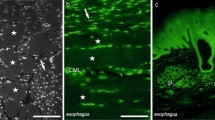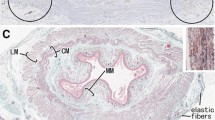Abstract
Light microscopy was undertaken on sections from the caudal flexure of the duodenum and the terminal ileum proximal to the ileocaecal fold in 5 control horses, 5 horses with acute grass sickness (AGS), and 5 horses with chronic grass sickness (CGS). With the exception of the ileal submucous plexus of the CGS group, the AGS group had the lowest number of neurons as measured using a subjective scoring scheme. The proportion of abnormal neurons in the AGS group was similar in both plexuses and both regions, whereas the values for the CGS group were much higher in the duodenal region than in the ileal region. The motility of tissue adjacent to that used for histology was measured isometrically in vitro. The increase in the rate of contractions following exposure to physostigmine was greatest for the AGS group, both from the duodenal and from the ileal region. The latency was longest for the AGS group, suggesting that the material from this group had the least number of active cholinergic neurons. The studies with physostigmine thus indicated that the most severe functional damage occurred in cases of AGS. These findings confirm that extensive damage occurs in the enteric neurons in equine grass sickness. There was good correlation between the functional cholinergic responses and the extent of neuronal degeneration.
Similar content being viewed by others
REFERENCES
Barlow, R.M., 1969. Neuropathological observations in grass sickness of horses. Journal of Comparative Pathology, 79, 407–411
Brownlee, A., 1959. Changes in the coeliac-mesenteric ganglia of horses affected with grass sickness and of horses affected with some other diseases. Veterinary Record, 71, 668–669
Culling, C.F.A., Allison, R.T. and Barr, W.T., 1985. Cellular Pathology Techniques, 4th edn, (Butterworths), 40, 158
Doxey, D.L., Pogson, D.M., Milne, E.M., Gilmour, J.S. and Chisholm, H.K., 1992. Clinical equine dysautonomia and autonomic neurone damage. Research in Veterinary Science, 53, 106–109
Doxey, D.L., Milne, E.M., Woodman, M.P., Gilmour, J.S. and Chisholm, H.K., 1995a. Small intestine and small colon neuropathy in equine dysautonomia (grass sickness). Veterinary Research Communications, 19, 529–543
Doxey, D.L., Pearson, G.T., Milne, E.M., Gilmour, J.S. and Chisholm, H.K., 1995b. The equine enteric nervous system-neuron characterization and distribution in adults and juveniles. Veterinary Research Communications, 19, 433–449
Gabella, G., 1989. Fall in the number of myenteric neurons in aging guinea pigs. Gastroenterology, 96, 1487–1493
Gilmour, J.S., 1973. Observations on neural changes in grass sickness of horses. Research in Veterinary Science, 15, 197–200
Howell, J. McC., Baker, J.R. and Ritchie, H.E., 1974. Observations on the coeliaco-mesenteric ganglia of horses with and without grass sickness. British Veterinary Journal, 130, 265–270
Hultgren, B.D., 1982. Ileocolonic aganglionosis in white progeny of Overo spotted horses. Journal of the American Medical Association, 180, 289–292
Murray, A., 1995. In vitro small intestinal motility in horses with and without grass sickness, (PhD thesis, University of Edinburgh)
Murray, A., Cottrell, D.F. and Woodman, M.P., 1994. Cholinergic activity of intestinal muscle in vitro taken from horses with and without grass sickness. Veterinary Research Communications, 18, 199–207
Obel, A.L., 1955. Studies on grass sickness. The morphological picture with special reference to the vegetative nervous system. Journal of Comparative Pathology, 65, 334–346
Pearson, G.T., 1994. Structural organisation and neuropeptide distributions in the equine enteric nervous system: an immunohistochemical study using whole-mount preparations from the small intestine. Cell and Tissue Research, 276, 523–534
Pogson, D.M., Doxey, D.L., Gilmour, J.S., Milne, E.M. and Chisholm, H.K., 1992. Autonomic neurone degeneration in equine dysautonomia (grass sickness). Journal of Comparative Pathology, 107, 271–283
Scholes, S.F.E., Vaillant, C., Peacock, P., Edwards, G.B. and Kelly, D.F., 1993. Enteric neuropathy in horses with grass sickness. Veterinary Record, 132, 647–651
Vonderfecht, S.L., Trommershausen Bowling, A. and Cohen, M., 1983. Congenital intestinal aganglionosis in white foals. Veterinary Pathology, 20, 65–70.
Author information
Authors and Affiliations
Rights and permissions
About this article
Cite this article
Murray, A., Pearson, G. & Cottrell, D. Light Microscopy of the Enteric Nervous System of Horses with or without Equine Dysautonomia (Grass Sickness): its Correlation with the Motor Effects of Physostigmine. Vet Res Commun 21, 507–520 (1997). https://doi.org/10.1023/A:1005998505369
Issue Date:
DOI: https://doi.org/10.1023/A:1005998505369




